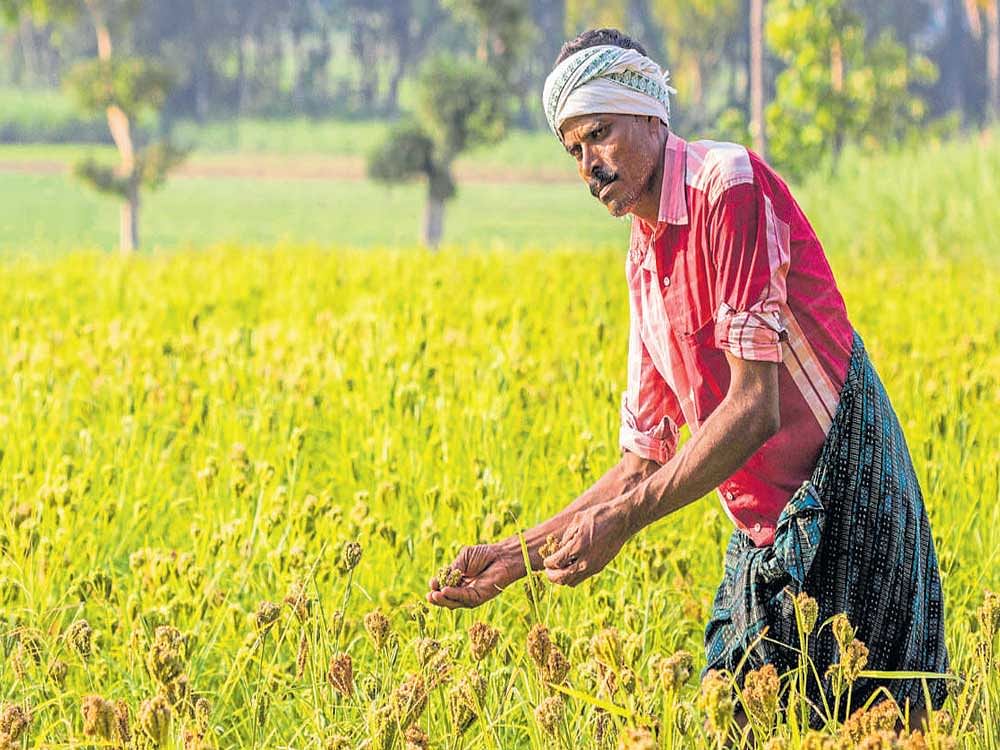
Mandya, known as the hub of paddy cultivation in South Karnataka, is gradually losing grounds due to water scarcity, reduced soil fertility and many other problems. Due to scarce rainfall and unavailability of water for irrigation, farmers here are finding it difficult to cultivate paddy even during the monsoons. The depletion of natural resources coupled with unpredictable weather patterns has forced them to look at alternative crops. One such farmer who has shifted to other crops successfully is Somashekhara of Shivalli village. He has been successfully growing finger millet varieties in his farm.
One of the staple crops of South Karnataka, finger millet has been cultivated traditionally in this region since ancient times. Naturally, we see a rich diversity of finger millet varieties in this region. A few decades ago, there was a surge in high-yielding varieties, which dominated over the local ones. Fortunately, some farmers had preserved local varieties by growing them in small patches. Sahaja Samrudha, a farmers organisation that has been working towards preserving and propagating heritage seeds, put in efforts to collect such heritage varieties from different finger millet growing regions of Karnataka and Tamil Nadu. So far, as many as 40 varieties have been collected by Sahaja Samrudha.
Somashekhara is one of the farmers motivated by this drive and he has been conserving 17 varieties. He sows the seeds in a nursery bed and transplants them after 25 days. He doesn’t give any input other than farmyard manure. He waters the plants only four times — soon after transplantation, after one month, while manuring and during flowering. So far, none of the diseases commonly seen in high-yielding varieties have affected these varieties. As a result, the crop has yielded well. Each finger millet variety has distinct properties and uses. If one variety is a short-duration crop, the straw of another variety is preferred as fodder. “People complain that heritage varieties yield only up to eight quintals. But that is not true. One can get a yield of up to 20 quintals with proper management,” says Somashekhara.
His wife Mani is happy that they could source and conserve a local variety, ayyana ragi, that was popular in the olden days. “My father used to tell us about this variety. But we hadn’t seen it. Now it feels good to grow and consume it,” she says. The finger millet varieties are named based on their appearance, properties or places of origin. Some varieties grown here include edagu ragi, Sharavathi ragi, ragalli Shivalli ragi, bonda ragi, kempu ragi, biligadda ragi, bennemudde ragi and hasirukaddi ragi.
Somashekhara’s experiment has proved that finger millet can be grown in this region in summer months too. “If farmers come forward to conserve at least one variety, that will help save and propagate the varietal diversity,” says seed conserver Boregowda.
The farmers in Mandya had forgotten finger millet as irrigation canals carry water to the fields perennially, prompting them to grow two crops of paddy. In the last two years, water supply was affected as drought hit the region and people had to limit to single crop of paddy. Consequently, farmers started growing millets in the summer season. While many have succeeded in it, Somashekhara’s effort stands out with many varieties.